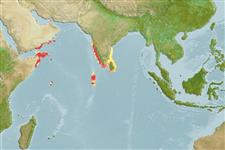>
Scombriformes (Mackerels) >
Trichiuridae (Cutlassfishes) > Aphanopodinae
Etymology: Benthodesmus: Greek, benthos = depth of the sea + Greek, desmos = bond, chain (Ref. 45335).
Environment: milieu / climate zone / depth range / distribution range
Ecología
marino bentopelágico; rango de profundidad 0 - 1000 m (Ref. 6181). Deep-water; 18°N - 3°S, 50°E - 92°E (Ref. 6181)
Indian Ocean: Arabian Sea and Bay of Bengal.
Tamaño / Peso / Age
Maturity: Lm ? range ? - ? cm
Max length : 51.0 cm SL macho / no sexado; (Ref. 6181)
Espinas dorsales (total) : 31 - 34; Radios blandos dorsales (total) : 68 - 74; Espinas anales: 2; Radios blandos anales: 64 - 67; Vértebra: 105 - 109. Body silvery, jaws and opercle blackish. The inside of the mouth and gill cavities black.
Found on seamounts and continental slope from 375 to 600 m, juveniles are mesopelagic from 100 to 300 (1,000) m (Ref. 6181). Minimum depth from Ref. 58018.
Life cycle and mating behavior
Maturities | Reproducción | Spawnings | Egg(s) | Fecundities | Larva
Nakamura, I. and N.V. Parin, 1993. FAO Species Catalogue. Vol. 15. Snake mackerels and cutlassfishes of the world (families Gempylidae and Trichiuridae). An annotated and illustrated catalogue of the snake mackerels, snoeks, escolars, gemfishes, sackfishes, domine, oilfish, cutlassfishes,. scabbardfishes, hairtails, and frostfishes known to date. FAO Fish. Synop. 125(15):136 p. (Ref. 6181)
IUCN Red List Status (Ref. 130435)
Threat to humans
Harmless
Human uses
Herramientas
Special reports
Download XML
Fuentes de Internet
Estimates based on models
Preferred temperature (Ref.
123201): 10.8 - 17.5, mean 12.7 °C (based on 22 cells).
Phylogenetic diversity index (Ref.
82804): PD
50 = 0.5005 [Uniqueness, from 0.5 = low to 2.0 = high].
Bayesian length-weight: a=0.00046 (0.00020 - 0.00105), b=3.12 (2.92 - 3.32), in cm total length, based on LWR estimates for this (Sub)family-body shape (Ref.
93245).
Nivel trófico (Ref.
69278): 4.0 ±0.7 se; based on size and trophs of closest relatives
Resiliencia (Ref.
120179): Bajo, población duplicada en un tiempo mínimo de 4.5-14 años (Assuming tmax>10).
Fishing Vulnerability (Ref.
59153): Moderate vulnerability (45 of 100).
